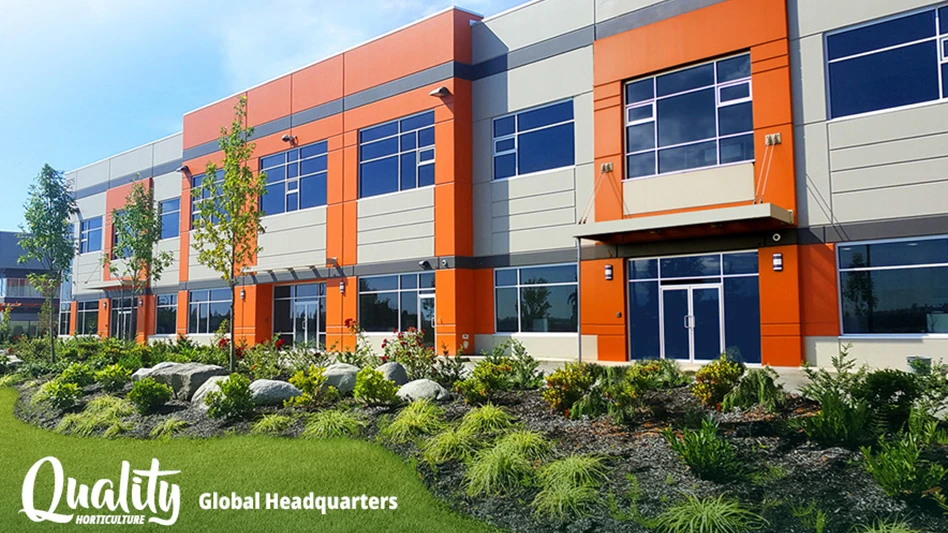.jpg) Julie NewmanGreenhouse operators must protect water resources and comply with increasing regulations. These include management practices that reduce agrichemical use inside the greenhouse, as well as practices implemented outside the greenhouse to contain runoff. Vegetated buffers outside a greenhouse can prevent pollutants, such as fertilizers, pesticides and container media, from ending up in surface and ground water.
Julie NewmanGreenhouse operators must protect water resources and comply with increasing regulations. These include management practices that reduce agrichemical use inside the greenhouse, as well as practices implemented outside the greenhouse to contain runoff. Vegetated buffers outside a greenhouse can prevent pollutants, such as fertilizers, pesticides and container media, from ending up in surface and ground water.
Types of vegetated buffers
A vegetated bioswale is a storm water conveyance system that channels storm water. This type of buffer system improves water quality by reducing flow velocity and increasing sedimentation, filtering pollutants and allowing infiltration into underlying soils.
A filter strip is a band of vegetation that can be used between a greenhouse and a water body. It slows runoff from the production area and traps sediment, fertilizers and pesticides before they reach surface water.
A constructed wetland is an artificial marsh or swamp for treating wastewater, controlling flood waters and reducing erosion. In greenhouse production, wetlands can be built to further remove pollutants in the effluent from a retention basin.
How vegetated buffers work
Most types of vegetative buffer systems work in a similar manner. Runoff containing soluble nutrients, pesticides and sediments with adsorbed pesticides, enters the buffer. Vegetation in the buffer slow surface flow and sediments drop out. Some water infiltrates into the root zone and subsoil, while the remainder becomes lateral subsurface flow.
When the roots of buffer plants grow to sufficient depth, they intercept infiltrated water, taking up the soluble nutrients and pesticides. Pesticides adsorbed into soil particles become trapped in the root zone, and high soil organic matter provides conditions for denitrification and pesticide degradation.
 Equisetum and other plants that tolerate poor drainage and wet conditions are placed in drainage areas to take up water and soluble nutrients and pesticides in these vegetative bioswales. The plants are periodically harvested as a crop.Site selection and design
Equisetum and other plants that tolerate poor drainage and wet conditions are placed in drainage areas to take up water and soluble nutrients and pesticides in these vegetative bioswales. The plants are periodically harvested as a crop.Site selection and design
When planning and designing a vegetative buffer, it is best to consult a licensed engineer or the Natural Resources Conservation Service (www.nrcs.usda.gov). Buffers need to be designed and constructed to comply with all federal, state and local laws and regulations. Local zoning regulations and other permit requirements may apply, and multiple agencies may be involved in the permit process. This is usually the case if a project is near a stream or wetland, if it involves constructed wetlands or if natural habitat or endangered species will be affected.
Plant selection
Plant selection decisions should be based on climatic and microclimatic adaptability, including plant hardiness and heat tolerance. Seasonal rainfall is also important, especially if supplemental irrigation isn’t planned for dry seasons.
Consider the cost of plants. Plants used in buffers are typically seeded, as this is generally the least expensive method. However, it is important to figure in the extra labor involved in weed control during the establishment of seedlings, as compared to transplanting plugs or liners or larger container plants. Stands of vegetation produced by transplanting may be more uniform than seeded buffers.
Growth rate and season of growth are also important factors. Growth during seasonal storms is important in the uptake of pollutants generated during these events. Plants that grow rapidly are easier to establish and can take up more nutrients from runoff. However, consider pruning, mowing and other maintenance tasks associated with rapid growth.
When vegetative buffers are used in natural areas that surround a greenhouse, it is preferable to use native plant species that blend with existing vegetation. Look for species that establish fairly easily. If ornamental plant species are considered for vegetative buffers, it is critical to consider the potential invasiveness.
Secondary crops
Some growers have successfully used vegetative buffers to produce secondary crops. It is important that there is a market for the selected plants or cut flowers and foliage harvested from the buffer, and that the market price will offset at least some of the production and maintenance costs.
Planting and maintenance
Planting should be timed so buffers are established prior to expected runoff.
Maintenance of vegetative buffers is necessary, including removal of trapped sediment. Watch for pests such as noxious weeds and invasive plant species, insects and vertebrates. Insect pests in buffers that can move into greenhouses may require treatment. But vegetated buffers can also harbor beneficial insects for use in integrated pest management programs. Mowing and pruning may be necessary to control plant growth and weeds. Mowing can stimulate growth and biological activity. Conversely, it can increase runoff flow and cause injury to some species if the mowing height is too short. Mowing must be conducted to avoid peak nesting seasons and reduced winter cover.
Julie Newman is environmental horticulture farm adviser, University of California Cooperative Extension, (805) 645-1459; jpnewman@ucdavis.edu.

Explore the October 2009 Issue
Check out more from this issue and find your next story to read.
Latest from Greenhouse Management
- North Carolina Nursery & Landscape Association announces new executive vice president
- Plant Development Services, Inc. unveils plant varieties debuting in 2025
- Promo kit available to celebrate first National Wave Day on May 3
- Applications now open for American Floral Endowment graduate scholarships
- Endless Summer Hydrangeas celebrates 20 years with community plantings
- Invest in silver
- Garden Center magazine announces dates for 2025 Garden Center Conference & Expo
- USDA launches $2 billion in aid for floriculture growers





